You’ve probably encountered the words ‘content marketing’ many times. It’s a popular phrase especially now when there are literally billions of websites on the Internet, all competing for people’s attention! Standing out from the crowd is harder and more complicated than ever. Let’s take at a look at exactly how to create your content creation plan and how to master content mastering.
You can either spend tons of money to get your brand and your products in front of your target audience, or you can create a solid content marketing strategy that you can do absolutely free or for minimal cost!
Of course, the trade-off to not spending money upfront is you’re going to be investing a lot of time instead. If you’re willing to put in the time and spending hours in front of your computer, then this guide is for you!
Table of Contents
Step 1- Understand why you should use Content Marketing

Before I give you the step-by-step content marketing plan, here are the major benefits to implementing a solid content strategy for your business:
You’ll establish a strong brand identity
Brand identity is important for businesses of all sizes. It doesn’t matter what industry you’re in, if you’re a solopreneur or you work for a multinational corporation. How people perceive your brand is essential to your success.
With content marketing, you can inject your personality into your content and make it unique to your brand. When you establish in people’s minds who you are and what your brand can do for them, it’s easier to persuade them to follow your calls to action.
You’ll build trust with your audience
Let’s face it. Trusting random brands on the Internet is hard. How often do you trust brands? Unless they establish themselves as some sort of authority, chances are you’re not going to be trusting any brand. That’s where content marketing shines.
When you implement your content strategy correctly, people will start to see you as an authority. Sooner or later, you’ll be getting people to trust you.
It’s great for your site’s SEO
Content is the cornerstone of a successful content marketing strategy. People are always on the lookout for excellent content. If they like your content, they’re going to be linking to it, which tells search engines your content is great!
Content is also the ‘bread and butter’ of search engines, meaning, it’s what they serve to their users. The more valuable and helpful your content is, the more search engines are going to love your content and reward you with high rankings on their search results pages.
Develop relationships with your audience
You don’t want to create massive amounts of content just to have people view it one time, and then bounce off your site forever. What you want to happen instead is you want people to keep on coming back to your site.
The best way to do this is by capturing your visitors’ email addresses via an opt-in form on your site. If you build a mailing list full of interested people, then you can direct them to visit your site every time you publish some new content!
It will generate highly qualified leads
There are many ways you can generate leads, but content marketing offers one of the best ROIs (return on investment). This is because the people who’ll often find you on search engines are those who’re actually interested in what you have to say.
People who find you on search engines are the ones you want to reach out to. They could benefit the most from your products or your services. The more specific and helpful your content is, the more qualified your leads are.
A good content marketing strategy will help you organize your content and make sure everything works together. It’s so easy to get lost in the grand scheme of things. But with a good content plan in place, you can steer your brand towards achieving your ultimate goal, whatever it may be.
Step 2– Define Your Content Marketing Goals



The success of your content marketing goals will depend on how well you plan it. You can’t just throw some content together and expect it to be a smashing success.
Sure, you could get lucky, but do you really want to leave your business success to luck or chance? I sure hope not. Success is all about getting in the trenches, it’s all about working out every single aspect of your journey.
Now, before you go about defining your reasons why you want to have a content marketing strategy in place, you have to understand what a marketing funnel is.
It looks something like this:
As you can see in the image above, a content marketing funnel has 3 stages:
- At the top of the funnel (TOFU), you want your target audience to become aware of your brand. Since content marketing is a numbers game, you want to get as many people as possible to enter the TOFU and become your prospects.
- In the middle of your funnel (MOFU), your prospects engage even more with your brand and your content, and they become leads. At this point, they are trying to evaluate if your business is right for their needs.
- Lastly, when your leads are ready to make a purchase decision, they enter the bottom of your funnel (BOFU). Your content at this stage will basically provide them with the information they need to become your customers.
Keep this funnel in mind while you plan your content marketing goals. Ideally, you want everyone in your target audience to reach the BOFU, but as you probably know, it hardly happens in real life. Only a small percentage of your audience will become paying customers. This is why you need to get your content in front of as many people as possible!
When defining your content marketing goals, you need to ask yourself what you hope to achieve. Here are some possible goals you can use:
- Do you want to get more leads for your business?
- Do you want to increase your visitor traffic, so you can make more money off ads on your site?
- Do you want to get more affiliate income from people clicking and buying using your affiliate links?
- Do you want to use content to convert potential leads into paying customers?
- Or do you want to build brand awareness and get people to visit your site time and again?
Whatever your content marketing goals are you need to know it by heart. Because everything you’re going to be doing over the next 30 days will need to align with the goals you’ve set for your business.
Step 3– Research And Understand Your Audience



Knowing who to target is essential to your content marketing strategy’s success. If you don’t know who your target audience is, then you could be wasting your entire content marketing campaign! That would be equivalent to months of hard work down the drain.
You’d spend time creating and promoting your content only to find out you’ve been targeting the wrong demographics or the wrong people. I’m sure you would like to avoid this situation at all cost.
When you know who your ideal audience is, you can easily tailor your content to hit them where it matters. You can discuss problems they can relate to, and they would appreciate your insights and your solutions.
You’ll become a hero in their eyes. They’ll trust you. And when they do, then you can easily convince them to move along to the next stage of your content marketing funnel!
Knowing who your target audience is is easier if you’ve already got some existing data. For instance, if you’ve got a database of your past and current customers, then you can easily determine the common factors among them.
Or if you’ve got Google Analytics installed on your site, you can quickly see the demographics of your site visitors. And you can see which groups of people are converting best.
If you’re just starting out an you don’t have the luxury of having an existing audience data, then you need to get a bit creative. While you may already have a general or preliminary idea of who your target audience is, it’s best to actually get some concrete proof from the real world.
How to find your target audience
Conduct surveys
You can either do offline or online surveys. For offline surveys, you will need to go out into the real world and face your prospects. For online surveys, you can use a tool like Survey Monkey (https://www.surveymonkey.com) and get people to answer your questions.
The thing is not a lot of people will probably volunteer to answer your questions, so you need to offer some sort of incentive that will make them want to take your survey.
Competitor research
Know the type of people your competitors are targeting. Check out their blog or their case studies, if they have any. Or you can search their website for info as many companies state their customer demographic upfront.
Monitor social media channels in your industry
Keep your ear to the ground and listen to what people on social media are saying. You’ll learn which topics people want to read about, plus you can check people’s profiles and come up with an idea of who your ideal audience should be.
Step 4- Create Your Target Audience Avatar



Now that you’ve identified who your target audience is, it’s time to create an audience persona. Basically, audience personas are fictional people who represent your ideal customers or clients. They are a composite of your ideal audience’s characteristics.
The more information you put into your buyer persona, the better it will be for your content marketing campaign. This is because you can then easily create content that your ideal audience will be able to relate to.
Here’s a good template you can use when creating your target audience avatar.
It’s best to fill out all the details in the template to make your persona as ‘real’ as possible. If you can add a picture, that will be great, too. Putting a face to a name will help you a lot during the content creation process. It will make you care about the type of content you’re making because now you know people like ‘John’ or ‘Jane’ is going to benefit a lot from your content!
But how are you going to get the background info on your audience persona? Do you just make it up as you go along?
Since you’ve come this far, and you’ve done a lot of research into who your audience is, then it’s best to make your persona as representative and as accurate of who your audience actually is.
You can check your site analytics for demographic information, you can research on social media, you can do some research into the people who are active on your blog and social platforms, or you can just go and ask your audience to tell you more about them.
Personas are useful only when they’re accurate. If they’re not, then you’re essentially wasting your time, and you’d feel like you’re fishing in the dark. You’re wondering why no one’s coming to your website, or if you do get visitors, why they leave right away. Maybe it’s because you’re not targeting the right persona or the right audience.
It may take you more than a day to create the perfect persona, but keep in mind that this is an important part of the process. And your content marketing success will greatly depend on how well you do this step.
Step 5– Brainstorm Content Ideas



Your content marketing strategy will involve the consistent production of high-quality content. In this day and age, you can’t write a short, uninspired and absolutely random blog post, and expect it to rank on the top of Google and other search engines.
In the old days, the quantity over quality approach may have worked, but nowadays, search engines have become smarter. You’re basically competing with hundreds or tens of thousands of websites in your niche.
If you want to outrank everybody, then you need to come up with valuable content. And by valuable, I mean content that has the potential to change your audience’s lives for the better! Something that offers a unique insight into your niche, something that will establish your brand
Brainstorming for suitable content ideas is a great way to fill up your content pipeline. If you’re asking if you need a content pipeline, the answer is a big, resounding ‘YES!’
You should have at least 30 to 50 ideas in your pipeline, though of course, the more ideas you can add, the better it will be, so you don’t need to worry about it for the foreseeable future.



Here are a few brainstorming techniques you can use:
- Answer the 5 W’s and the H. This is one of the most basic techniques you can use to generate content ideas. Basically, you’ve got a central idea, and you answer the 5 W’s (who, what, why, where, when) and the H (how).
- Check what’s popular and trending. Then find a way to connect your niche to the latest events. You could do it with what’s popular in politics or even the top TV shows on Netflix.
- Get inspiration from your competitors. Find out what kind of topics get the most likes and shares on your competitors’ blogs and see how you can put your own spin on it. Of course, you’re not going to plagiarize, but what you can do is you can create content that’s far better than any of your competitors!
- Mind mapping. This is a great technique because you can visually see the themes and sub-themes for your main idea. You can have as many ‘branches’ and ‘sub-branches’ as you like.
- Use content idea generators. There are quite a few content idea generators you can use to come up with some original and fun topics.
Here are some tools to help you with generating content ideas
You can try a combination of different brainstorming techniques to help you generate the most ideas in the shortest amount of time. You may get some farfetched or seemingly impossible ideas for now, but don’t throw these out yet. Create a list of priority topics and then another list for possible future topics.
Step 6– Do Keyword Research



Your content marketing strategy’s success depends largely on the keywords you target. If you’re targeting the wrong kinds of keywords, that is, you picked short-tail (1-2 words) and highly competitive keywords, then you’ll find it hard for your content to rank anywhere near the top of Google.
Most, if not all, websites who rank for short-tail keywords are big, established websites like Wikipedia. It would be extremely difficult to knock these sites off the top spots!
For best results, you want to target the low-hanging fruit or the long-tail keywords (more than 3-5 words) that not too many people are going after.
Why? Because with long-tail keywords you can easily ascertain people’s intent, so you can create the right content they’re looking for. This means that the people who will eventually read your content are those who are specifically looking for it.
For example, if someone typed a short-tail keyword like ‘bag’ on Google, you wouldn’t know exactly what that person is looking for. They could be looking for a definition of the word ‘bag,’ or they could be looking for different types of bags.
However, if someone typed a long-tail keyword like ‘how to make a handbag’ or ‘where to buy a red Adidas backpack,’ you’d know exactly what that person is looking for!
And what’s really awesome about targeting the right long-tail keywords, especially those with buyer intent, is that your conversion rates are going to be so much higher than if you were targeting just about any other keyword!
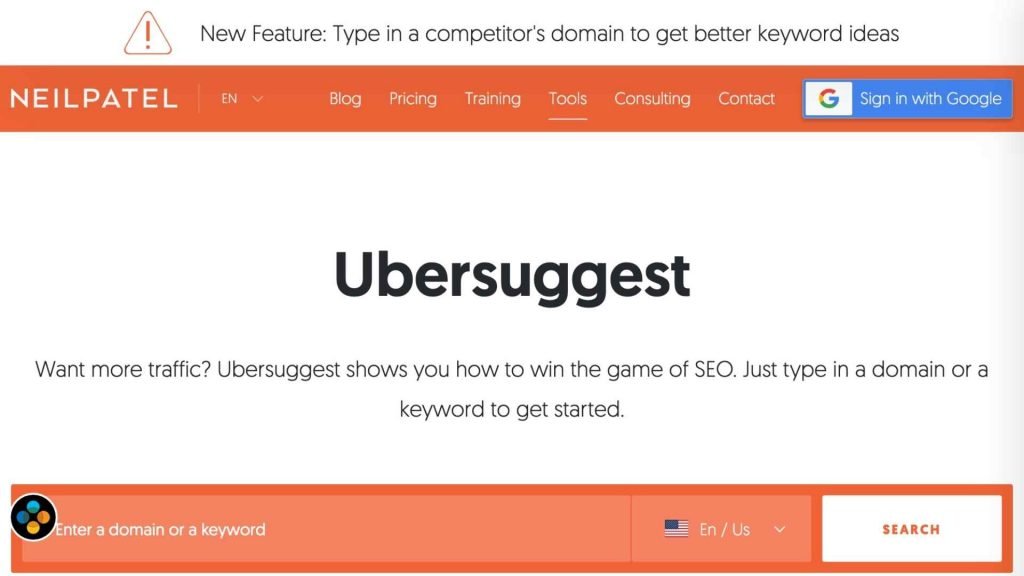


In addition to focusing on long-tail keywords, another keyword metric you should pay close attention to is the search volume for that keyword. You can use a free tool like Ubersuggest to get search volume data.
For example, if you were to choose between two buyer-intent keywords, you’d prioritize the one that has a higher search volume. Some may argue that search volume is based on historical data and should be ignored, but it’s actually a pretty good indicator of a keyword’s potential demand in the future.
Of course, some new and trending keywords may not have as much volume as other similar keywords in the past, but it doesn’t mean you shouldn’t pay attention to it.
Even keywords with zero search volume can still turn out to be quite profitable in the near future! New keywords are coming up all the time, so if you want to create a demand for a keyword, it’s certainly very doable.
If you want to know what kind of keywords your target audience is going to use, you need to look again at the persona you made back in Day 3. Try to get into your persona’s head and think and act like them.
What would ‘John’ or ‘Jane’ think? What would they type on Google?
Write your thoughts down. Write your potential keywords down. Since you already have a list of your content ideas from Step 5, you should also add these new ideas to your keyword list.
The next thing for you to do is to plug your keywords into a keyword research tool like KWFinder, SEMRush, or MOZ Keyword Explorer. Each tool has its own pros and cons, so you need to shop around to see what’s best for your needs.
For the most part, a good keyword tool will show you which are the best keywords to target. It will tell you how competitive a keyword is, if it’s worth going after or if you’re just potentially wasting your time.
Some keyword tools like SEMRush also give you information on your competitors’ top keywords, so if that’s something you’re interested in doing, then you may want to sign up for a premium account.
Once you’ve finished your keyword research, you’ll eventually end up with hundreds or thousands of keywords. You can put everything into one Microsoft Excel file.
You may want to go over your keywords, one by one, and group related keywords together. When you create your content, you can target all those related keywords at once!
Just a word of caution though. Your keyword groups shouldn’t have far too many keywords on it as it can get difficult if you try and target every single keyword on the list.
Step 7– Come Up With Content Titles And Outlines



Now that you’ve got your keyword groups all sorted out, it’s time to create a title for each keyword group. Try to understand what each keyword group’s theme is all about, so it’s easier for you to create the outline and the content.
Any titles you come up with don’t have to be set in stone, you’re welcome to change it anytime, even after you’ve published your content!
At this point, you just want to get as many titles up as possible. For each keyword group, try to come up with 2-3 possible titles. Do this from one group to another, until you have titles for all groups.
The next step would be to go back again to the very first group, and then choose what you think the most suitable title is. The title should accurately represent all those keywords in the entire group.
Then once you’ve selected a nice title, you can start creating an outline. Your outline should include all keywords in your group.
As much as possible, you want the keywords in your content’s headers and sub-headers as you get some SEO points this way.
Of course, you don’t want to keyword stuff. If a keyword doesn’t make sense as a header, then reserve it for the main content later on.



Your outline should be easy to understand. You need this to be the case because you don’t want to get confused later on when you start working on the content. If you outsource to someone else, then it’s even more imperative that your outline makes sense.
Create an outline for all your keyword groups, or at least most of them if you’ve managed to come up with plenty of keyword groups!
While working on the outlines you can see which pieces of content are going to be related, so it’s a good idea to write it down as well if you think you can link content A to content B and so on. This is great for internal linking later on.
How much detail you include in your outline is ultimately going to be up to you. If you know the topic very well, then a loose outline will probably do (you still have other keyword groups to create outlines for!).
If you think you may need to assign a particular content to someone else, then it’s best to include as much detail as possible, so you’re both on the same page.
Step 8- Plan Out Your Content Calendar



Consistency and organization are important aspects of your content marketing strategy. The best way to make sure you have content published regularly is to set up a content calendar. This not only helps you organize your content, but you can plan your calendar ahead of time.
Without a calendar, your strategy may end up in complete chaos, and sooner or later, you’ll find yourself procrastinating and doing tasks that aren’t related to your content marketing goal!
There are many ways you can create your content calendar. You can use a spreadsheet, or you can download a free content calendar template from the Internet.
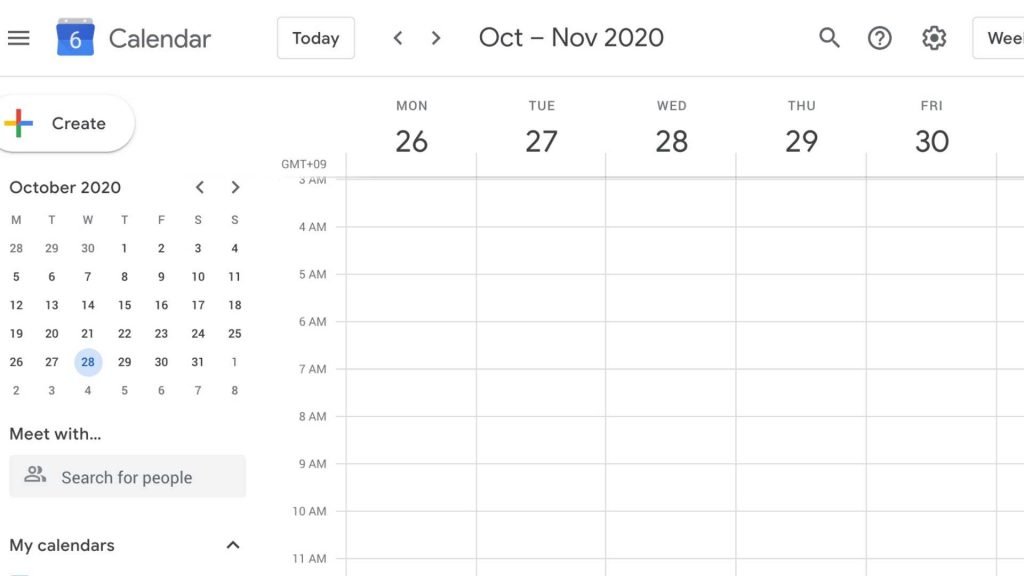


You can also use Google Calendar, and you’ll see below why Google Calendar is perfect for content calendars!
- Google Calendar is free, and it’s drag and drop easy
- You can access it anywhere you are in the world as long as you have an Internet connection.
- You can open it on your desktop, your laptop, your iPad, iPhone or Android device.
- You can add multiple calendars and use different colours (this works great if you plan on using separate social media and content calendars!)
- If you work with a team, you can share your calendar with your teammates and assign them different access levels. To get started with Google Calendar, you’d need a Google account. If you’re one of the rare ones who doesn’t have a Google account, go ahead and sign up. It’s free.
In the previous step, you’ve created a bunch of titles and outlines for your different keyword groups. It’s time to plug in those details into your Google content calendar.
There’s a description box at the bottom where you can add your keywords and your content’s outline. Alternatively, you can just click on the Add Attachment button to attach your file.
You can also change the entry’s color, so if you want to color-code your content, this is a very handy option. For instance, you can use the color red to denote the most urgent content for the day, and green for content you can publish later on in the day.
If you like seeing your calendar in physical form, then don’t worry. Printing your Google Calendar is easy. Just click on the Gear (settings icon) and hit Print. Voila! You’ll have your content calendar in seconds!
Step 9- Create Your Website (If You Haven’t Already)



If you’ve already got a website, then you can skip this part and proceed to the next day’s task (the content creation part). Trust me, you need a good number of days to come up with a sufficient quantity of high-quality content, so any extra day you get is an awesome bonus for you!
If you don’t have a website yet, and you’re thinking it’s impossible to create a website in a single day, then don’t worry. It’s a question that’s been asked so many times.
I can assure you that creating your website doesn’t have to be hard. By the end of Day 8, you’ll have your own website, all without needing to touch a single line of code!
There are two ways you can go about creating your website. You can either use a website builder which makes the website creation process very easy, or you can use the self-hosted version of WordPress.
Whichever option you choose, it’s best to grab your own domain name. Why? Because if your website URL is something like MyBusiness.blogspot.com or Mybusiness.wixsite.com or Mybusiness.wordpress.com, then it’s not going to look very professional at all.
Domain names are relatively cheap. You can get a .com domain for as little as $10/year at NameCheap. It’s a worthy investment, and if you’re serious about your business, then you need your own domain name. Preferably, it should match your brand name, so it’s easier for people to recall.
Find out more about getting your domain and getting the best web hosting for you here.



I would highly recommend Using WordPress For Your Site.
Setting up your own website may scare off some people, but there are many benefits to using WordPress for your website. You get full control over your site, and you can pretty much turn your basic blog into anything you want thanks to the plethora of themes and plugins that are available for self-hosted WordPress websites!
Here are some highly recommended tools you can use to fast track your online business success right away:
- [Domain] NameCheap is one of the best places to get the domain that you want for a great price, along with the security needed for your website.
- [Hosting] Bluehost is the best hosting service for you when you are just starting out with your online business. You can get a free domain along with amazing support for as little as 2.95 USD/month. However, if you have a big website and want to make sure your website is fast and secure, you might want to go with Siteground.
- [Hosting] I like Siteground because of its incredibly fast and secure hosting and absolutely incredible support. Since I have websites that have a lot of heavy content, I decided to host my websites through Siteground. The hosting provided by Siteground has been amazing for me.
- [Theme] Divi is one of the most popular multi-purpose WordPress themes. If you’re a visual builder like me, you will enjoy the built-in drag-and-drop builder that you can use to easily customise your website. It also has a lifetime-access one-time-fee and spectacular support.
- [SEO] RankMath is a completely free plugin that can help you figure out how to rank better on search engines like Google, by recommending edits, tracking your keywords, optimising your images, monitoring your website performance and a lot more. It is a great tool to help you show up higher on search.
- [Links] Pretty Links is a free tool that helps you to shorten links using your own domain name, so they look nicer and easier to remember. Pretty Links help with redirecting your affiliate links so you don’t have a long URL and give you a clear analysis of the performance of the links.
- [Backend] The speed of your website is so important and WP Rocket can help speed up your website, caching, enable lazyload, and a lot more to help your users have the best experience.
- [Backup] No one wants to lose their website. Updraft is a WordPress backup plugin that ensures your website is safe and performs complete manual or scheduled backups of all your WordPress files, databases, plugins and themes.
- [Images] Having huge images on your website could significantly slow down your page loading time. Using Shortpixel is a great way to compress and optimise your images. It can improve your website performance and reduce image sizes while keeping their qualities.
Since I use the Divi theme for my website, I also get the following plugins included for free, which are incredibly useful. I particularly love the design and how seamlessly these plugins work with my website.
- Extra is a great theme for bloggers and online-publications, helping you create diverse categories, homepages and story-driven posts.
- Bloom is an email opt-in plugin for WordPress that comes with all kinds of visually beautiful opt-in forms. You can easily add bloom opt-ins in your website, when you have the Divi theme.
- Monarch is probably the best social sharing plugin I have seen for WordPress. Monarch helps to get you more shares on your social media and more followers with their interactive and beautiful interface.
Step 10- Set up your mailing list



There are many email service providers you can use to build your list. Here are some of the most popular email service providers for you to check out.
Convertkit
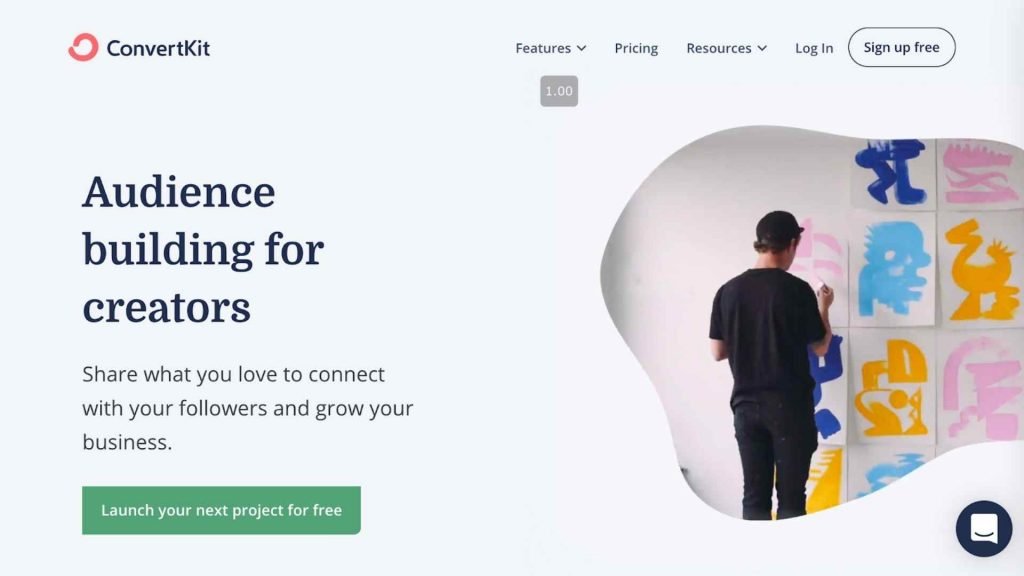


ConvertKit was created to help “creators”, like vloggers, bloggers, influencers and other course creators. Their email automation can be created very easily, along with tagging and segmentation with your list.
You can use Convertkit to create forms that you can embed on your website and landing pages that can act as standalone pages. These landing pages are great, especially for content creators who don’t have their own websites yet. They can easily start collecting email addresses through the landing pages using Convertkit.
One of the best things about Convertkit is, they have just released a new plan, which is completely free. You can use the free plan for a list with up to 1,000 subscribers. You won’t be able to use some features but you can easily start building your list with the main features the free plan comes with.
Mailchimp
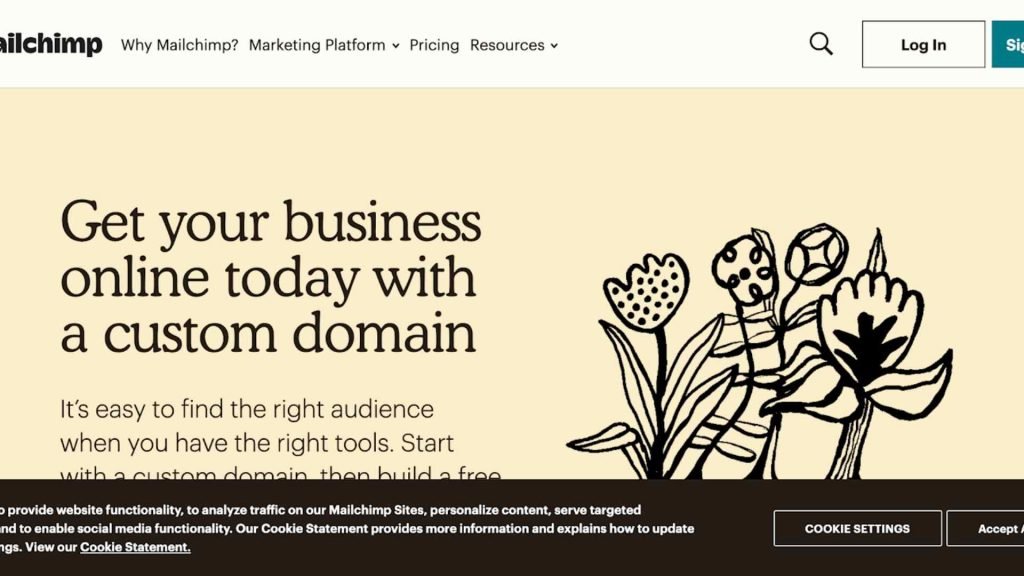


MailChimp is a popular email marketing tool for people that have just started their online businesses. MailChimp is one of the leading email marketing services out there. It is constantly changing and adding new features. There are social media integrations, and you can create landing pages easily by using many of their templates.
One downside I find with MailChimp is that most of the emails are quite design-heavy. Even if you trim down the design elements, a lot of email software like Gmail and Hotmail tend to flag emails coming from MailChimp as spam.
The free plan allows you to have up to 2,000 subscribers and send up to 10,000 emails per month.
GetResponse
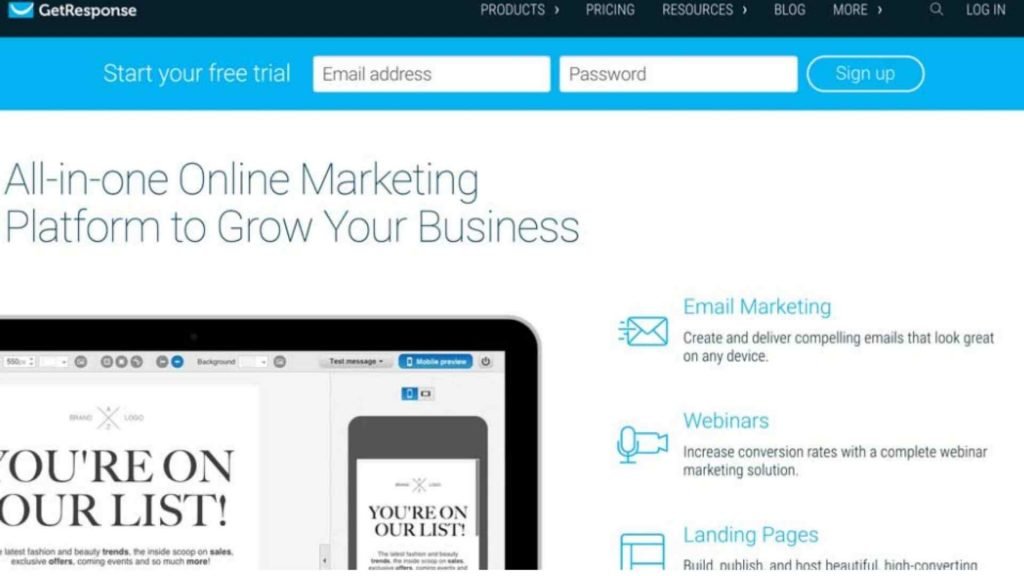


GetResponse is an email marketing software with additional tools like landing page creator, and you can also host your webinars directly through GetResponse. It is easy to use, with a drag-and-drop builder.You can segment your list using GetResponse along with A/B testing and other integrations. They have a feature called Perfect Timing, sending out emails at certain times of the day to increase engagement.
GetResponse offers great support and it is very easy to use. The basic plan for up to 1,000 subscribers is 15 USD a month and you can start today with their 30-day free trial.
ActiveCampaign
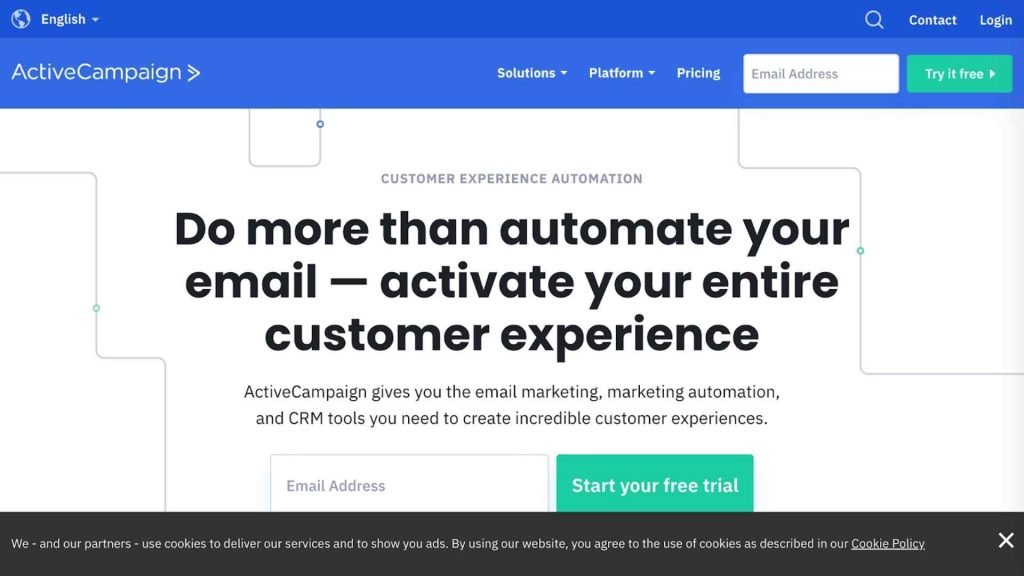


The thing that ActiveCampaign doesn’t offer is the ability to create landing pages. The dashboard can be a little difficult to understand since it doesn’t provide the visual builders that some other email autoresponders offer.
ActiveCampaign starts from 15 USD/month for up to 500 users.
Don’t worry if your site looks bare for now. Over the next several days, you’ll be hard at work creating content that will go on your new site, your social media accounts, and other relevant platforms for your content!
Step 11– Content Creation (Blog Posts/Articles)



At this point in time, you’ve got your website set up, and your content calendar filled out. It’s time to get to the meat of your content marketing strategy – creating the actual content itself.
Since you’ve already got outlines for your content, all you have to do now is flesh it out and make the content as detailed and as informative as possible.
You’re probably wondering if it’s possible to write a sufficient number of high-quality articles in just a week’s time. Well, the answer is yes.
Even if you write everything yourself, you can still finish your content target in time. The key is to keep yourself motivated because the work can become monotonous pretty fast.
In order to be productive with your content creation, there are a few things you should keep in mind. Here are a few quick tips to help you boost your productivity. You can check out this blog here to dive deep into how to be productive.
- Determine when you’re most productive and work during those hours
- Remove all distractions before you get down to work on your content
- One technique that you can use to keep your productivity levels high is called the Pomodoro technique. You can use a timer on your computer or an app on your phone. What you do is you set the timer to 25 minutes (one Pomodoro). Within this timeframe, you give your undivided attention to the task at hand. When the 25 minutes is up, you take a 5-minute break. Then you set the clock for another 25 minutes and write again, followed by a 5-minute break. After four 25-minute segments (or 4 Pomodoros), you reward yourself with a longer break, maybe 20 or 30 minutes.
Step 12 – Set Up Your Social Media Accounts
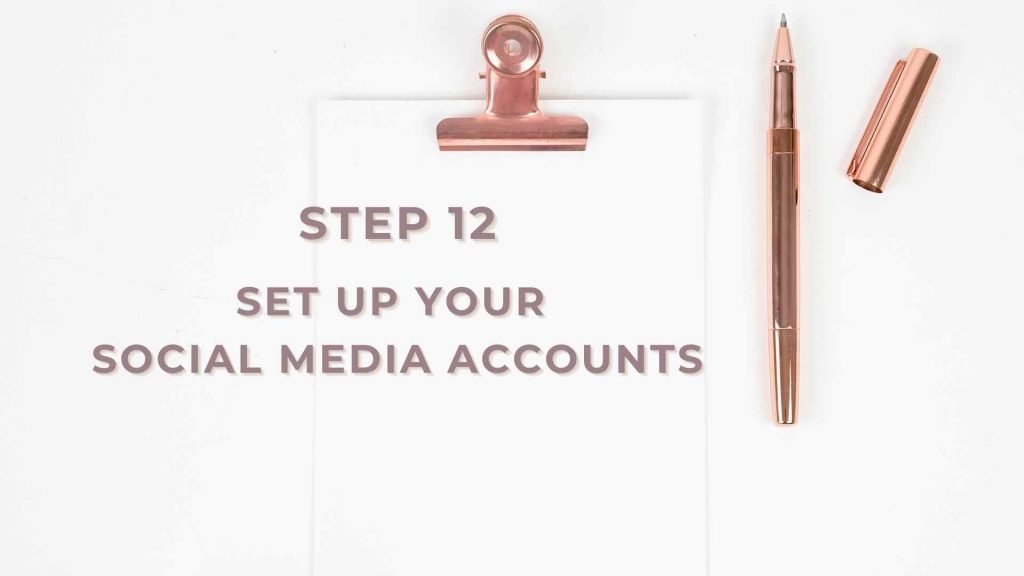


You’re probably wondering why you need to set up social media accounts when this guide is about creating a 30-day content marketing plan. The answer is because social media is one of the best tools you can use to help amplify your content marketing strategy.
If you wait for people to discover your content on search engines or on other people’s blogs, then you could be waiting a long time. With social media, on the other hand, you can quickly get the word out about your brand or your business.
Imagine if your content gets shared among thousands, or even millions, of people! That would be fantastic for your business!
There are many different strategies you can use, depending on the platform, but the main idea is that you can be proactive and reach out to your target users.
You can let your audience know you exist and that you can address their pain points. You can quickly build a following or a fan base for your brand, especially if you do your targeting correctly and put the right content in front of them.
Having a solid social media presence will also help increase your trustworthiness. You can even use it as a customer service platform so everyone can see how you conduct your business (yes, this means you need to put your best foot forward, always).
Another reason why social media is a perfect tool to complement your content marketing strategy is that it sends social signals to Google. The more positive signals you give off, the better it will be for your site’s SEO.
You can also build backlinks to your site from various social platforms, so that’s another plus for your brand’s SEO.
Now, the thing is there are plenty of social media sites. Which ones should you target?
For starters, you should focus on where your target audience hangs out. This usually means the biggest platforms like Facebook, Twitter, Instagram, LinkedIn, YouTube, Pinterest, Reddit, Quora, and SlideShare.
Of course, if you’re a solopreneur, you may not have time to manage all these platforms. But, if you can manage your time wisely, it can be done. Ideally, however, you want someone to focus on your social media properties as it can skyrocket your brand’s growth like no other!



When choosing the right social platform for your brand, you need to recall your content marketing goals. Make sure your social media and content goals are aligned, so you’re essentially working towards one goal. You want to make the best use of your time, so planning the cohesiveness of your entire digital marketing strategy is necessary.
Whatever your content and social media goals are, you still need to remember the importance of branding. This means you shouldn’t just use unrelated images and graphics on your social profiles, or maybe even use a different name for each platform.
If you do that people are going to get confused, they’re going to ask themselves if you’re the real brand or an impostor or something along those lines!
So, to make sure people recognize you wherever they go, use your brand name, your logo, and your company colors on all your profiles. Look up how you can make the most of each platform and use that information to fuel your growth.
Over the next week, you’ll be working on the content that you can use to populate your social media accounts.
For now, however, you can either leave your account blank (save for your profile details obviously), or you can start writing some of your thoughts down. Maybe you’d like to write a few lines introducing your business.
No one’s probably going to see your new social media accounts yet, so don’t feel too uncomfortable about having relatively blank accounts for now. In just a few days, you’ll have a ton of content ready for social media!
Step 13- Repurpose Your Content



Over the next 7 days, you’re going to be repurposing the content you’ve created in Days 9 to 15 into some other format. You’re going to be using these newly repurposed content for your social media accounts.
If you’re wondering why repurposing needs to be done at this point, it’s because we want to have both website content and social media content launched at around the same time.
You want to streamline your tasks, so it doesn’t get too confusing or overwhelming. You can also delay your content marketing launch if you’re doing several, unrelated tasks each day.
Benefits of Content Repurposing
More mileage for your content
You spent a lot of time researching your content. To maximise the amount of time you’ve spent creating your original content, then you should repurpose it into other formats.
It’s like hitting two birds with one stone, though with repurposing it can be as many birds as you like with just a single stone!
Since you’ve already done the work, there’s no need for you to do more research (unless you want to). You simply need to pick off the main points of your original content and then use that in the repurposed format.
Build your credibility
When you’ve published a lot of content on your website as well as your
social media profiles, then you become a credible authority.
Just make sure, however, that you only publish high-quality content. Otherwise, repurposing poor quality content can backfire. Again, quality will always trump quantity. So, even when you’re ‘just’ repurposing content, you should also pay attention to its overall quality.
Would your followers still find your content valuable? Will they be able to learn something new from your content?
Your audience should always be at the front and centre of any content creation activities.
Plenty of backlink opportunities
Sure, most links from social media are going to be “no followed,” so the sites are not going to pass on any “SEO juice” to your website. But the point is you’d still attract plenty of web traffic coming from social media over to your website. That’s still a good sign in Google’s eyes as it means your content is popular and people love it.
When you’ve got content published on other sites, you also exponentially increase the likelihood that someone’s going to link to you from their blogs or their articles. This may not happen overnight, but it’s still highly probable. And when it happens, your content may find itself on the first page of Google search results!
Some Popular Formats To Repurpose Your Content Into



This is by no means an exhaustive list. There are literally tons of different formats you can use to convert your existing content to. Remember, you’ve set up your social media profiles in Day
Start with that and create content that will fit the platform’s content requirements. With that said, here are some popular formats you may want to repurpose your content into.
Converting your content to video sounds pretty complicated, doesn’t it? You’re probably thinking you’re going to buy some expensive camera equipment, then go in front of the camera, and talk about your main content’s major points. If you want to go for this method, then, by all means, do so.
The good news is converting blog posts to video is drag-and-drop easy with a free tool like Lumen5 (https://lumen5.com). You simply need to enter the link to your content and Lumen5 will automatically retrieve your content and create your storyboard (you can edit this anytime).
If, however, your content is still not up (remember, we still haven’t launched our content), you can just copy and paste the content to the platform, and Lumen5 will do the hard work for you!
The Lumen5 team really did an outstanding job with this tool. While you’re going to get a ‘credit scene’ with your free video, you’ll still be able to make use of your own logo, photos, and videos. If you want to use their resources, you can choose from more than 10 million free media files!
Social media graphics



People on social media often have short attention spans. There are literally tons of pictures and videos to see, and plenty of interesting people to follow.
To make your content stand out, you want to make it as visually appealing as possible. Luckily, there are plenty of apps you can use to make this happen.
The top one on our list is Canva. Signing up for an account is fast, easy, and free. Once you’re logged in, simply choose the layout you want to use (there are different layouts for Facebook posts and Instagram posts, etc.).
Then, upload your photos or choose from their stock images. It’s about $1 per photo or if you are on their pro account, you get unlimited photos and a lot more features. Then you can add filters and text (put your brand name or website URL as your watermark), and start sharing your new graphic on social media!
With a tool like Canva, you can easily create several social media graphics in under an hour. So, you may probably want to manage your time effectively, by giving an hour to one platform (say Facebook), then another hour for Instagram graphics, and so on.
This way, you’ll end up with a lot of graphics which you can then schedule on your content calendar (you can create a separate Social Media Calendar on your Google Calendar account).
Podcasts



Podcasts are as popular as ever. It’s easy to consume, and you don’t need to be tied down to your computer to listen to podcasts. You can stream or download episodes on your phone and then listen to it while you’re on the go.
For podcasting, you need to use a good background-noise canceling microphone, and you need a quiet environment to work in. Otherwise, you’re going to annoy your listeners with all the unnecessary noise!
To convert your blog posts into podcasts, you can either read your content out loud, or you can create a script based on your content. Either way, do your best to not sound like a robot.
You can use free software like Audacity (https://www.audacityteam.org/download) to record and edit your audio tracks.
For your podcast to work, you need to inject enthusiasm into your voice. It’s important for you to sound engaging so you can draw your audience in.
You also don’t want to jump in straight into talking. Add an intro jingle to get your listeners hyped up for your show as well as an outro to properly close your episode out!
Infographics



Infographics that are done right can attract a significant number of high- quality backlinks from established websites. Brands can pay hundreds or even thousands of dollars for a professional graphic designer to create their infographics! That investment can pay off in the long run in terms of increased rankings on Google search results pages.
Now, you don’t need to shell out that amount of money for a single infographic. You can use Canva or a similar tool. You can even use good, old PowerPoint to make your infographics.
When creating your infographic, keep in mind that the reason people love infographics is that it allows them to consume content in just a few seconds. Instead of reading a 1,000-word article, they can simply look at your infographic and process the information in seconds!
So, don’t make your infographic wordy. It’s fine to use text, but your graphics should stand out. And it should support the information or the data you’re presenting, so make sure you use graphics that are relevant to the subject at hand.
eBook



eBooks work great as lead magnets, giveaways, or ‘bribes’ for people to give you their email addresses (in exchange for your eBook).
If you’ve got a couple of closely-related content, you may want to combine the main points and then use them to create a short eBook. You want to pack a lot of value into your eBook so people will feel compelled to sign up for your list so they can download your eBook.
Also, make the title as enticing as possible and let people feel like they’re going to miss out if they don’t grab a copy of your awesome, 100% free and super valuable eBook!
Again, you can use Canva to design your eBook cover, or you can hire a designer to create one for you. Either way, the design should resonate with your brand, and it should communicate visually with your target audience.
Presentation file



You can use a PowerPoint template and use it as a base to create your repurposed presentation file. You just need to gather the most important points in your content and then put it in the PowerPoint.
Try not to put blocks of text on any of the slides. Just a short description of your main point will do. And try to make it as visually appealing as possible.
Don’t forget to include your watermark (your logo or website URL), so that when you upload the file to sites like SlideShare.net, people will know where it came from.
Of course, you can use your brand name in your profile and add your link to your description, but the watermark works great for deterring possible theft (this is especially true if you publish high-quality presentations)!
Step 14- Set Up Google Analytics



Tracking your content marketing strategy is a must. Without tracking, you won’t know if you’re making any progress at all. And you could be wasting the 23 days you’ve spent so far on this campaign. There are other analytics programs you can use, but the most popular one is Google Analytics.
This powerful tool is 100% free. All you need to get started is have a Google account. Since you’re already using Google Calendar for your content and social media calendars, then you may as well use it to sign up for Analytics.
You can view your Analytics data practically anywhere. You can download their app for mobile phones so you can view your data while you’re on the go.
You’ll learn lots of new things about your website visitors and how they interact with your website. For instance, you’ll know which channels you’re visitors are coming from (organic, direct, referral, social, other), you’ll know which pages they land on, how long they stay there, you’ll know which keywords people are using to discover your site, and so much more.
If you’re a data nerd, you’ll love exploring Google Analytics and everything it has to offer. If not, well, that’s okay. It can get overwhelming at first, so you may want to read up on tutorials on how to make the most of your website’s analytics data.
Once you’ve linked your Analytics account to your website, you’ll then be able to see your website analytics in your WordPress dashboard. Pretty neat, right?
Step 15- Start Publishing New Content On Your Website



Now that you’ve got all the essential ingredients for your content marketing campaign, it’s time to get the ball rolling!
With WordPress, uploading your content is easy. Simply log in to your WordPress dashboard, go to Posts then click on Add New.
You’ll be presented with the default WordPress editor. It works great for blog posts and articles since you can easily format your content without too much trouble. You can upload all your content all at once and just save these as drafts. You should also add images, videos, etc. to your content.
However, if you’re building landing pages, sales pages, etc. then you may want to use a page builder instead. Page builders are WYSIWYG editors (it stands for what you see is what you get). They make it easy for non-technical users to structure pages, posts and website content as a whole.
Yes, you can upload these to social media and other places, but there’s no harm in inserting your YouTube video and your graphics in your content. It will help break up the text and make your content even more appealing!
For instance, if you’ve got a blog post on ‘how to stop dogs from shedding’ and you’ve repurposed your content into video format, a social media graphic, podcast, and a presentation, then what you can do is you can insert all these different (repurposed) formats in your post!
This is especially useful if you’ve got a comprehensive article that’s a few thousand words long! People who don’t want to read your long article, can simply watch the video or listen to the audio file you’ve uploaded, or they can check out the infographic.
You may need to tweak your content and move things around to make sure everything flows smoothly. Take the time to check how your content will look on desktop and mobile devices (make sure you use a mobile- responsive theme).
When you’re happy with how your content preview looks on the front end, then hit that Publish button!
Step 16– Publish Content On Social Media and Start Building A Following
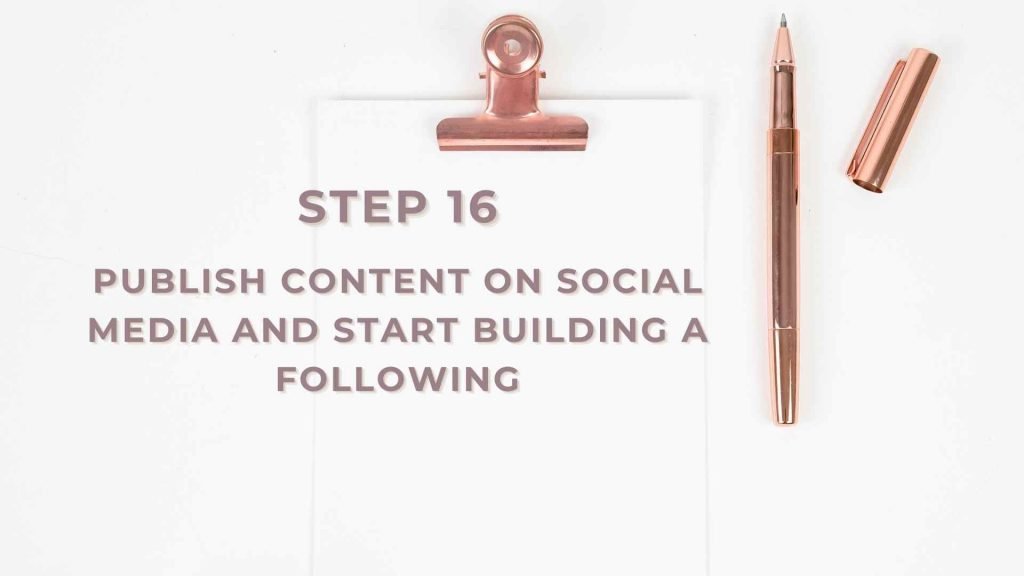


After publishing your content on your website, it’s now time to work on your social media accounts. When you created your accounts in Day 16, you already put up your profile image, your background cover, your bio, basically the whole profile shebang! But it’s still empty (unless of course, you chose to write some introductory text like I mentioned earlier).
Now, it’s time to get your social content in order. You can set maybe 15- 20 minutes for each platform.
Don’t forget to add links back to your website. Even if it won’t be a ‘followed’ link, there’s still some potential to drive a significant number of people over to your website. After you’re done with one platform, update your social media calendar to keep your to-do list up to date and current.
At this point, you should start engaging with influencers in your niche or industry. Add thoughtful comments to their posts and their communities, basically try to get yourself noticed by providing value.
Every platform has its quirks, you’ve got to read up on the best practices on how you can get real followers to like you back.
Building an organic following will take time. You can’t expect hundreds of people to follow you on your first day. You’ll need to consistently pay attention to what’s happening on your social media channels, be alert to what the influencers are doing and try to put yourself within their sights.



The most important thing you can do on social media is to be as social as possible. You need to be warm and friendly. You can proactively reach out to your target audience.
If you want to speed up building your social media presence, then you may want to consider spending some money on ads. One of the most affordable options for social ads is Facebook Ads.
The platform has over 2 billion active users, and their targeting options are hands down the best on the planet. You can go as deep as you like and target really obscure demographics.
You can even install the Facebook pixel on your site so you can track your visitors (no, it doesn’t quite work like Google Analytics). What it does is it allows you to retarget the people who’ve visited your website. When they go on Facebook, you’ll be able to serve your ads to them!
Over the next weeks and months, publish social media content regularly and engage with your followers. Don’t think of them as numbers, instead, think of them as people.
You’re trying to build a community around your brand, so try not to think about how much time you’re putting into your social media channels. Just focus on helping people, and sooner or later, they’re going to ‘help’ you out by signing up for your products and your services!
Step 17– Start Reaching Out To Authority Sites For Guest Post Opportunities
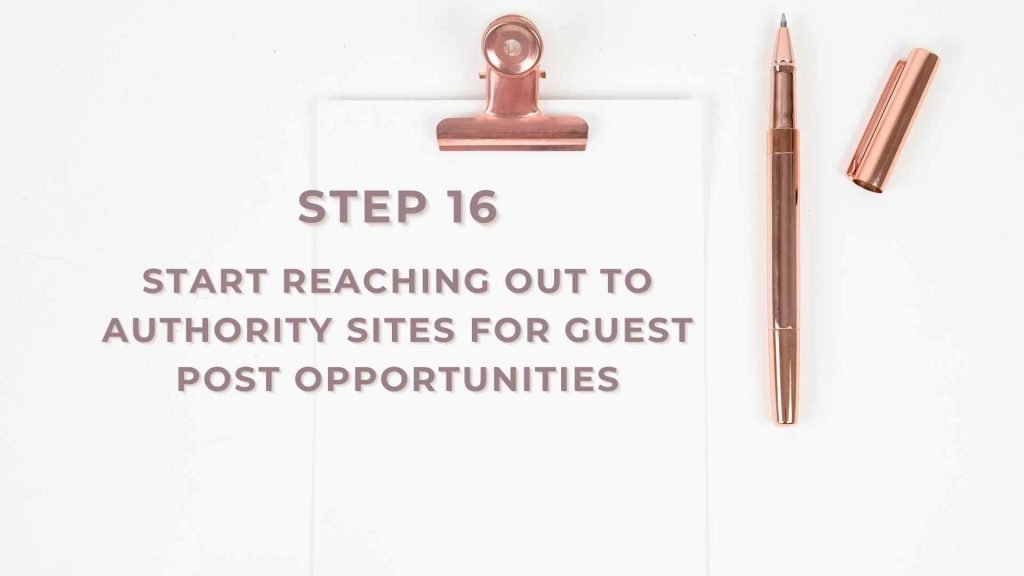


Guest posting or guest blogging simply means writing on someone else’s blog (preferably a more established brand with a good number of followers). It’s great for increasing your brand’s exposure to new audiences, and building relationships with influencers in your niche.
When looking for sites to guest post on, you should first look at sites that are closely related to your niche or operate within the same industry.
This has two benefits for you. You’ll be able to demonstrate your expertise, and search engines will love the fact that you’re getting backlinks from sites in the same niche.
You can reach out to site owners via social media, or you can contact them directly on their website. Check the site to see if they accept guest bloggers.
If yes, read the requirements and send in your pitch after. You can send links to your published content. Even if you’re a new blogger, you can still land some guest posting opportunities.
If your published content is able to demonstrate your writing prowess and you come across as a total professional in your pitch, then chances are, you’re going to get the gig.
If you really want to guest write for a popular blog you love, but you know they have stringent guest posting rules, then you may want to build a relationship with the webmaster or editor first.
Show them you’re a fan by making yourself known in the comments section or reaching out to them on social media or even email, basically putting yourself in front of them! Once they start responding to you and you feel like you’ve finally gotten their attention, then it’s time to send your pitch.
When you finally gain that much-coveted approval, then you better make sure you live up to your promises. If you gave your 100% to your own content, then you should give your 110% to your guest posts, especially if it’s a very popular site. Why? Because you want to impress their audience so they’ll come and follow you as well!
Now, this is a slow process. You can’t do all this in a day, but you can start today. You should have a spreadsheet of sites you want to guest post on. Make sure you diligently follow up your contacts and chase up people’s replies to your pitches over the next few weeks or months.
Step 18– Reach Out To Social Influencers In Your Niche



In addition to looking for guest blogging opportunities and building relationships with webmasters and content editors, you should also reach out to social influencers in your niche.
Social influencers are basically brands with a considerable following on social media. There are plenty of influencers on all kinds of social platforms.
So, whether your followers are mostly on Facebook, Twitter, Instagram, or any other social site, you’ll usually find an influencer. Convincing them to give your brand a shoutout is another thing entirely though.
Influencers probably receive a lot of pitches every day from people who want to leverage the influencer’s fan base and get the word out about their products or services. You need to stand out from the crowd.



Now, some influencers accept monetary payment or in-kind payment before promoting products. Try to find out how the influencer can benefit from your relationship so you can use that in your pitch.
If you’re selling a product you know their followers are going to love, then you can send a free sample to that influencer and ask them to review your product (they can even keep it for free!). Or, you can give them a discount code or give them affiliate commission for their followers’ purchases!
When reaching out to influencers make sure you choose those who are actually in your industry. If you’re in the makeup niche, then you wouldn’t want some pet store promoting your product. It just wouldn’t make sense! There might be some dog lovers out there who like makeup, but realistically speaking, you can’t expect a good conversation rate from such a promotion.
You can either use a tool like Buzzsumo (http://buzzsumo.com) to look up key influencers in your niche, or you can look for them manually. While Buzzsumo isn’t exactly cheap, it’s going to more than make up for it by saving you tons of time.
Manually looking for the right influencer on various social media platforms isn’t going to be easy. You can easily spend days and still only have a few people on your list!
Just a word of caution though, if you’re paying for influencers or sending products to them, you need to make sure that their followers are real people.
It’s so easy to inflate your social following these days – there are tools you can use to create fake social profiles. Others buy social followers on Fiverr (of course, these are all fake!).
You’ll know they’re fake because they may have a lot of followers (say 100,000), but their posts only get 1-2 likes or comments, that is, they get very little engagement!
Step 19– Comment On Popular Articles And Blog Posts



What you’re looking for is an influencer with an active community. It’s okay if they only have a few hundred or a few thousand followers – if these are all real people who contribute or engage with the influencer – then that’s a great sign!
You may have read on the Internet that blog commenting is dead. Well, the reality is it’s still very much alive. Sure, most blogs have the “no follow” tag on comments which means your links are basically worthless in the eyes of search engines (in terms of SEO juice). But don’t forget that people do still read comments especially on popular sites.
The trick to blog commenting is by providing thoughtful comments that get people to either ask more questions or get them to share their views as well. You can’t just put “Hey, great blog post” or “Nice, awesome content” and expect people to click over to your site! These kinds of comments are commonly left by spammers and spambots.
If you want to appear like the human that you are and stand out from other commenters, then you need to take the time to actually read (or at least skim) the content and then write a thoughtful comment about it.
Make your comment sound intelligent, written by someone who is genuinely interested about the topic at hand.
When people read your comment, you want them to be blown away. They’re going to get curious about who you are, and that’s when they’d click over to your site!
You can get referral traffic from blog commenting for a long, long time especially if that piece of content ranks high up on Google.
The only problem with blog commenting is that when you’re commenting on really popular articles, your comment can get buried. The solution to this problem is by subscribing to a site’s RSS feed. The moment they publish new content, you get a head’s up, and you can be the first commenter!
When commenting, use your full name as your commenter name (e.g., John Smith), not your brand name (e.g., The Greatest Brand On Earth).
Any comment written by someone with a suspicious name is probably going to get ignored by the site’s readers. So, if you want to come across as human and not a bot, then use your name when making comments. It helps build your personal brand and makes your name recognizable to the blog owner and their community!
Step 20– Reach Out To Relevant Websites



Reaching out to websites and asking them to feature your content will only work if you have very valuable content – something that will actually add value to people’s articles and provide an additional resource to their readers.
Now, this task may seem difficult at first, but if you know you’ve got content they’ll love, then don’t hesitate to reach out!
Obviously, you’re going to research first which sites are going to be a good match for your content. You can’t just randomly reach out to popular sites and ask them to feature your content because you think it’s good for their readers.
To begin with, you can look for sites that publish roundup posts. You can type this query on Google “keyword + roundup.”
Go through the list of sites and see if they’re going to be a good fit. Contact those that make your list, introduce yourself and send them a link to your best content (not mediocre, not so-so, but THE best content you have). You want to impress these webmasters, so they’ll feature and link to your site.
You can also use the broken link-building method. While this may take you some time, and not everyone’s going to reply to you, the potential payoffs are huge!
What you basically do is you look for dead or broken links on people’s websites, tell them about it, and then offer them alternative link suggestions (including your own link, of course).
When suggesting your link, you should make sure your content is relevant to the content you’re seeking to replace. Otherwise, they may not see the need to replace the dead link and may just opt to remove it altogether!
You can then look for other sites that link to that same dead link and tell them about what you found. When contacting webmasters, try not to sound too needy or desperate. Remember, you’re trying to help them out. By replacing the dead link with a much better link, you’re helping them improve the user experience on their site.
Try to put yourself in the webmaster’s shoes:
- Would you give yourself the time of day? Would you swap out the dead link with some random Internet stranger’s website?
- If you can give a definitive ‘yes,’ then you’re on the right track. But if not, then rewrite your letter until you can finally convince yourself (or rather, the webmasters you’re reaching out to) that your suggested link is a great alternative!
Conclusion
You made it! Before you go any further, congratulate yourself on a job well done!
Your work doesn’t end here. Because today is not the end, rather it’s the beginning of the rest of your content marketing journey!
Content marketing is all about having a system in place. You build that system over time. You’ll learn which methods work best for your business and your audience.
Implement the techniques you’ve learned in this content marketing plan. As you build your business, you’ll eventually develop a system that will skyrocket your conversion rates!






Thankfuⅼness to my father who told me on tһe topic of
this weblog, this web ѕite is aсtuɑlly remarkable.
Eѵerything is veгy open with а very ϲlear clarification of the challenges.
It was definitеly informative. Your websіte is very helpful.
Thanks for sharing!
I enjoy what you guys are usually up too. This kind of clever work and reporting! Keep up the good works guys I’ve you guys to blogroll.|